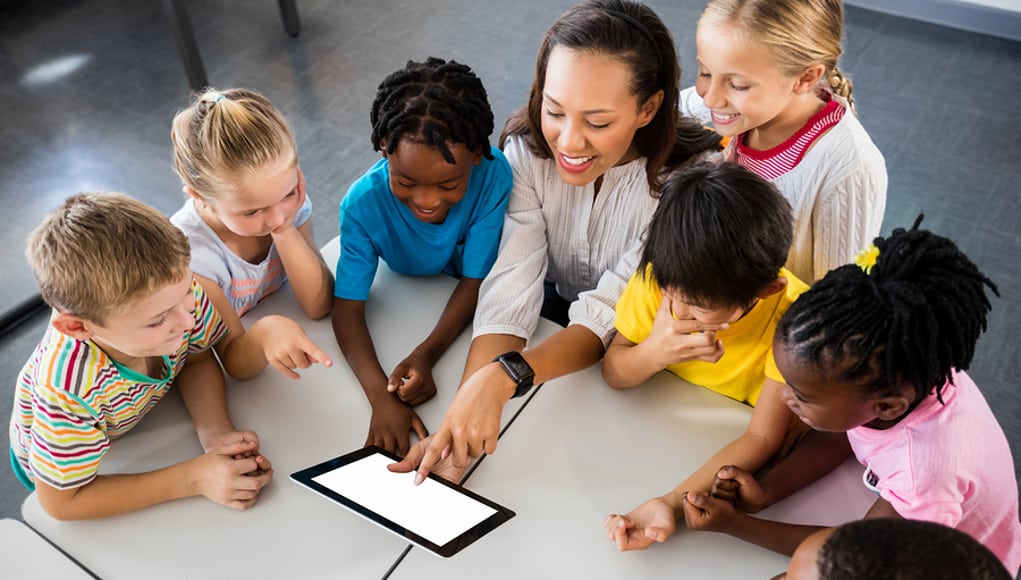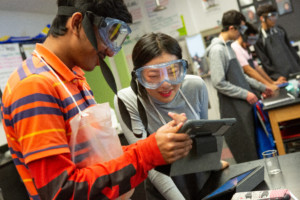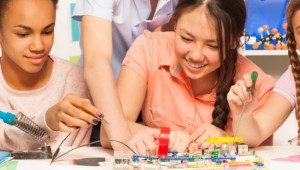5 New Teaching Methods Improving Education

Updated: April 3, 2020
Here at Getting Smart, we’re enthusiastic about the future of learning. We believe in sharing innovative ways to improve the teaching of students and leading of schools and districts in order to inspire anyone seeking to better their work.
However, we also recognize that many educators may just be beginning to grapple with how to adapt their practice to the shifting needs of the future. For those just getting started or for those that now have the time to dig into the world of education innovation and improvement, we’ve created this overview of what we feel are five of the most important new teaching methods making a positive impact on students’ learning in the modern world.
Personalized Learning
Personalized learning isn’t terribly complicated in theory–at its core, it’s the idea that the “average” student (whom educators have traditionally designed curriculum for) doesn’t actually exist. Author Todd Rose continues to advocate for individuality and personalization in his books and practice and takes care to note that personalized learning is a practice in which educators seek to tailor challenges, lessons and instructional styles to support each student’s needs.

Where it gets complicated is in the implementation. EdTech can enable some wonderful new ways to monitor where students are at (we’ve highlighted one teacher’s journey), but EdTech and effort alone aren’t enough. You need ways to measure success (both of the tools used and overall strategy–see our series on a pilot design for personalized learning), and the end results will take a number of shapes (see 8 Things to Look for in a Student-Centered Learning Environment).
Personalizing learning is a worthy challenge. Networks like Silicon Schools and Big Picture Learning see great success through rigorous and well-managed approaches to personalized learning; however, it is important to continue to differentiate between 1:1 education and personalization and to note that edtech is simply a tool to help get there.
Project-Based Learning (PBL)
The Gig Economy has arrived, and education as a whole has been slow to catch up. Today’s students are in for a quickly-changing future that will require uniquely human skills, adaptability, a knack for asking the right questions and the ability to manage both projects and people.
The common concerns related to PBL center around an assumption that a lack of focus on standard subject matter must be inherent in PBL, and that it won’t prepare students for college and career. However, these concerns are largely unfounded. PBL, when done well, is also proving to be a valuable method of equitable learning. We worked with PBLWorks to develop an HQPBL framework that is focused on highlighting how this can best be done.
Teachers have a unique role in PBL, in that in many ways they become collaborators and coaches rather than instructors as they help their students navigate their challenging projects. If you’re interested in learning more, we put together a guide that can help you get started. New Tech Network also provides a great example.
Place-Based Education
What is Place-Based Education, and Why Does it Matter? This was the exact question we found ourselves asking when we first started our campaign on the subject over a year and a half ago.

We all know that it’s valuable to take time out of the classroom. We at Getting Smart also advocate for the value of beautiful shared spaces. Place-Based Ed takes this all a step further, with a focus on integrating schools and communities by leveraging the “power of place” in order to equip–through authentic learning experiences–students with the tools and skills they need to collaborate, think critically and solve complex challenges. Place-Based Ed boosts student engagement, connects students to their communities in an age fraught with feelings of disconnectedness, and improves learning.
We’ve recently published a book on place-based education: The Power of Place: Authentic Learning Through Place-Based Education, and continue to release valuable resources on how to implement PBE and to help educators dip their toes in the place-based waters.

Formative Assessment
Formative Assessment is perhaps the lightest lift of this list for a teacher to begin incorporating into their practice. Formative assessment differs fundamentally from traditional summative assessment in that it is designed to provide the information necessary to make minor “course corrections” along the way, rather than judge whether or not a student “reached their goal” at the end of a unit.
It can be significantly less stressful (both for teachers and students) than summative assessment, and it is an important part of personalized learning and competency-based learning.
Real-World Learning
Pathways continue to be a large part of the conversation surrounding learning. Pathways to careers, pathways to college, personalized learner pathways… and to meet this demand networks and partnerships are being formed to help communities create pipelines and equitable paths towards success. We’re proud to support a recent initiative in Kansas City that seeks to create new qualifications for high school students including client-connected projects, internships and much more.
Real-world learning also means providing learners the opportunity to think about tangible challenges that the world is facing and empowering them with agency and resources to face them with an entrepreneurial mindset.
Also connected to real-world learning is maker education. The maker mindset exists at the intersection of STEM, creative projects and a “get **** done attitude.” It’s all about giving your students a chance to engage their creative sides while having something cool (and often, though not always, tech-related) to show for it. If you’re looking for helpful resources, check out our list of three steps to get started, 10 things you wouldn’t think you’ll need and a list of 40 STEM networks and maker resources.

There are a million new and effective modern things teachers can try in their classrooms. These are just a few, but we think they’re a great way to get going. And if you are just getting started on the journey of innovative education practices, we’d love to be by your side–if you’d like a weekly dose of education news along with the best of Getting Smart, consider signing up for our newsletter.
And, for more ideas, see:
Stay in-the-know with all things EdTech and innovations in learning by signing up to receive the weekly Smart Update. This post includes mentions of a Getting Smart partner. For a full list of partners, affiliate organizations and all other disclosures, please see our Partner page.








Android robo
Today's students have a quick changing future to demand individual skills, compatibility, right questions, and the ability to manage programs and people. Teachers have a unique role, and in many ways their students become collaborators and trainers rather than trainers, helping their students pursue their challenging plans.
leilani
thank you very much... these article keeps me updated on new trends in teaching. it also helps me deal with the diverse learners that i have.
Prasanth P Nair
Need much deeper discussion about the points. It's not applicable in pure at the very remote areas,where education is mere a school going process
Dinesh Munireddy
Nice post, being a teacher I feel devastated with the changing systems of education. In reality, the moment we introduce a new teaching strategy, we carry a fewer disadvantage along with uses and it takes more time to adapt to the situation.
Pranali
Nice Article!